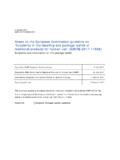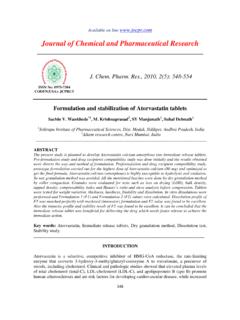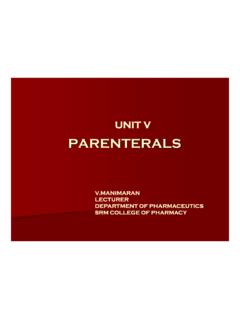Transcription of COMMITTEE FOR PROPRIETARY MEDICINAL …
1 The European Agency for the Evaluation of MEDICINAL ProductsHuman Medicines Evaluation Unit7 Westferry Circus, Canary Wharf, London E14 4HB, UKSwitchboard: (+44-171) 418 8400 Fax: (+44-171) 418 8551E_Mail: , 28 January 1998 CPMP/QWP/155/96 COMMITTEE FOR PROPRIETARY MEDICINAL PRODUCTS(CPMP)NOTE FOR GUIDANCE ONDEVELOPMENT PHARMACEUTICSDISCUSSION IN THE QUALITY WORKING PARTY (QWP)February 1996 TRANSMISSION TO THE CPMPN ovember 1996 RELEASE FOR CONSULTATIONN ovember 1996 DEADLINE FOR COMMENTSMay 1997 ADOPTION BY CPMPJ anuary 1998 DATE FOR COMING INTO OPERATIONJuly 1998 CPMP/QWP/155/961/8 DEVELOPMENT PHARMACEUTICSNote for guidance concerning the application of Part II, sections of the Annex to Directive75/318/EEC, as amended, of the data required for the granting of a marketing INTRODUCTIONP harmaceutical development studies need to be routinely carried out to establish that the type ofdosage form selected and the formulation proposed are satisfactory for the purpose specified inthe application.
2 They also aim to identify those formulations and processing aspects that arecrucial for batch reproducibility and which therefore need to be monitored of the great variety in active ingredients and dosage forms, this note for guidance is onlyan illustration of the type of information which has been found useful in establishing the factorswhich affect quality of a finished product. Individual guidance may be elaborated for specifictypes of product, following the general principles illustrated in this note. The note has beenelaborated primarily for products containing chemical active substances, but may be applicablealso to other types of product. In the case of biological products, such as vaccines and bloodproducts, alternative approaches may be COMPONENTS OF THE results of compatibility studies of the active substance(s) with the excipients should beprovided where appropriate.
3 In the case of fixed combination products, compatibility of theactives with each other should also be results of preliminary stability studies should be provided as supportive data if CharacteristicsPreformulation testing of the active substances may provide useful may be necessary to consider the physico-chemical characteristics of the active substance(s) inthe formulation in relation to the proposed dosage form and route of a physical parameter is demonstrated to be variable and critical for the quality of theproduct, it needs to be controlled by an appropriate method with acceptance criteria in the activesubstance specification or by other appropriate means, This may result in additional physicaltests for active substances used in specific formulation ( solid dose forms) over and abovethose for more simple formulations ( solutions) or those tests laid down in a of physical characteristics which may need to be examined include solubility, watercontent, particle size, crystal properties etc.
4 :i)Solubility may affect choice of formulation and choice of analytical )Water content can affect other parameters such as crystal properties and particle size, andcan influence )Particle size may affect bioavailability, content uniformity, suspension properties,solubility, )Crystal properties and polymorphism may effect solubility, bioavailability or , these parameters are inter-related and may need to be considered in limits for key parameters affecting bioavailability need to be derived from batches ofproduct showing acceptable in vivo and other non-active constituentsThe choice and the characteristics of excipients should be appropriate for the intended explanation should be provided with regard to the function of all constituents in theformulation, with justification for their inclusion. In some cases experimental data may benecessary to justify such inclusion preservatives (cf Note for Guidance Inclusion ofpreservatives and antioxidants ).
5 The choice of the quality of the excipient should beguided by its role in the formulation and by the proposed manufacturing process. In somecases it may be necessary to address and justify the quantity of certain excipients in of excipients with other excipients, where relevant (for examplecombination of preservatives in a dual preservative system) should be stability data may be novel constituents are used in the manufacture of the product, a new matrix ofa prolonged release preparation, a new propellant or permeability enhancer, fullinformation on the composition and function of the constituent in the formulation of theproduct should be furnished together with documentation to demonstrate its safety (PartIII).A new substance introduced as a constituent will be regarded in the same way as a newactive ingredient and full supporting data required in accordance with the Note forGuidance on Excipients, unless it is already approved for use in food for orallyadministered products, or in cosmetics for topical administration.
6 Additional data maystill be required where an excipient is administered via an unconventional route, or inhigh FORMULATED PRODUCTSThe therapeutic activity, posology and route of administration of the active substance and theproposed usage of the product should be taken into consideration when designing theformulation of the use of overages in the formulation of MEDICINAL products is a practice which in general termsneeds to be discouraged because of the risk of are primarily employed to cover losses during manufacture of active substances or keyexcipients, manufacturing overage, and/or during shelf-life stability overage. These canbe distinguished since in the former case there is unlikely to be increased dosage administered tothe patient, whereas the stability overage will result in overdosing where batches of product mayreach the patient soon after release.
7 The inclusion of any overage should be justified. Largeoverages (for example in excess of 10%) should not normally be used to cover up inherentlyunstable formulations - it is better to reduce a shelf life rather than to risk exposing a patient toCPMP/QWP/155/963/8excessive doses of a drug. Similarly overages should not be used to cover up imprecise orinaccurate analytical test procedures or sub-optimal manufacturing processes. The introductionof an overage of an active substance into a formulation should always be justified on the groundsof safety and efficacy of the product. It should also be remembered that over dosage may beintroduced by the mechanism of delivery, deposition of a metered-dose inhaled drug in chemical parametersa)pHEvidence should be presented to show that the effect of pH within the range specified in aformulation has been properly investigated.
8 Consideration should be given to the effect of pH onactive substances and, where relevant, on the excipients such as antimicrobial preservatives. ThepH profile of an active substance may be useful in investigating the bioavailability of productsadministered by the oral such a study show pH dependency any long term effects would need to be investigatedduring stability studies. Physiological implications of pH should also be addressed. Where it isnecessary to control pH within a narrow range the use of buffers may be )Other parametersDepending on the formulation, such parameters as dissolution and redispersion, particle sizedistribution, aggregation, rheological properties, etc. should also be considered duringpharmaceutical development studies. In the formulation of parenteral products, considerationmay have to be given to such factors as tonicity adjustment, globule size of emulsions, particlesize and shape as well as changes in crystal form, viscosity and/or syringeability* and Semi-solid of the formulationThe concentration of key components in the formulation should be shown to be appropriate fortheir intended purpose by experimental results.
9 These components might be : antimicrobial preservatives antioxidants others including surfactants, solvents, chelators, permeability enhancers, tablet lubricants,release modifers preservatives may need to be added to multidose products that inthemselves are not self-preserving (cf note for guidance on preservatives) but should notusually be added to sterile single use preparations. Consideration should be given tofactors such as storage conditions, reconstitution, dilution before use and frequency ofopening the pack, in choosing the levels of suitable preservatives. Testing the efficacy ofthe preservative system should be conducted according to the test method of theEuropean Pharmacopoeia. It is expected that the system will comply with level A criteriaunless otherwise justified. The test should be properly validated including the use ofappropriate negative and positive controls, and the choice of suitable organisms todemonstrate appropriate antibacterial and antifungal activity.
10 *Syringeability can be considered to be the ability of a product to be successfully administered by asyringe and appropriate needle, and this should be clearly demonstrated where packs intended for dispensing may require more stringent testing. The testingprogramme should allow the assignment of an "in-use shelf life" for the product whichwill subsequently appear on the product literature. This period should be as short aspossible especially for products intended to be sterile such as parenteral or shelf lives applied to large packs should be justified and may require additionalsimulated in-use microbial challenge tests as described in the note for guidance sizes should themselves be carefully chosen to suit the intended purpose andfrequency of use. Content of the preservative during shelf life is controlled by theappropriate finished product may be sacrificially degraded during the manufacture or shelf life of theproduct.
















